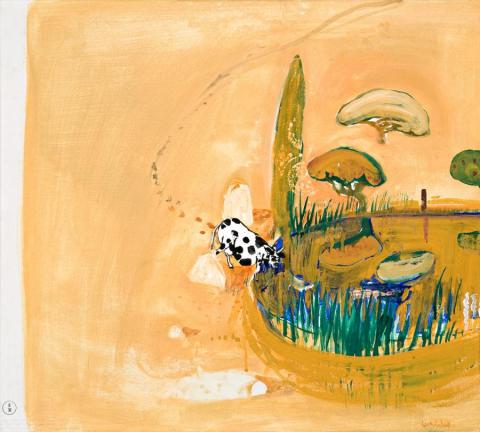THE COW, c.1979
Brett Whiteley
mixed media and collage on paper on board
60.5 x 68.5 cm
signed lower right: Whiteley studio stamp lower left
inscribed lower left: on the road from Bathurst to Goulbounre [sic] stop the car looking down on paddock Sept. 2nd / make twenty minute sketch instead of taking / polaroid intend to make 4 in one day fresh quick inscribed and signed verso: ‘The Cow’ / Brett Whiteley
Barry Stern Gallery, Sydney
Private collection, New South Wales
Private collection, United Kingdom
Bonhams and Goodman, Melbourne, 23 April 2007, lot 665
Company collection, Melbourne
'Of all the subjects Whiteley painted in his career, landscape gave him the greatest sense of release.'1
Awarded the prestigious Wynne Prize for landscape painting in 1977, 1978 and 1984, Brett Whiteley possessed a widely celebrated talent for recording the natural environment. As Barry Pearce elaborates, nature offered the artist both inspiration and solace: 'If in many of his other themes Whiteley confronted the difficult questions of his psyche, landscape provided a means of escape, an unencumbered absorption into a painless, floating world.'2
Returning to Australia in 1969, after a tumultuous decade abroad, Whiteley was captivated afresh by the beauty, vastness and variety of the Australian landscape. He turned first to the sparkling panorama and 'optical ecstasy' of Sydney Harbour's Lavender Bay. He then revisited the landscape of his boyhood, in the central eastern New South Wales towns of Oberon, Kurrajong, Marulan, Carcoar and Bathurst. The soft hills and fields of the countryside surrounding his school in Bathurst had provided Whiteley with inspiration for many years. Equally influential had been the landscapes of Lloyd Rees, which the young artist had first admired at Macquarie Galleries one day after school; as he later recalled in a letter to his artistic mentor, 'they contained nature and ideas, they contained naturalism but seemed also very invented, and the adventure of them was that they showed decisions and revisions that had been made while they had been painted. I had never seen anything like that before it set me on a path of discovery that I am still on today - namely that change of pace in a painting is where the poetry gets born.'3
Like the Heidelberg school before him, Whiteley now dedicated himself wholly to the landscape, observing and frequently painting en plein air the myriad effects of light upon the harsh Australian bush. In the heat of a summer's day, On the Road from Bathurst to Goulburn, 1979, is a superb example of the landscapes from this period - the elongated poplar tree, rounded boulders and arabesque shape formed by the meandering footprints and watering hole all drawing the viewer's eye upwards, in a manner reminiscent of the Chinese and Japanese aesthetics to which Whiteley was so partial. The composition epitomises the artist's abiding concern to capture the true essence of a place '...beyond the possibilities of paint alone - with its inclusion of real elements from the location. Witty and creative use of mixed media was especially common during these years; as Sandra McGrath notes, 'he was not beyond putting in real cow dung to heighten verisimilitude, as his earlier Marulan landscape showed.'4
1. Pearce, B., Brett Whiteley: Art and Life, Art Gallery of New South Wales, Sydney, 1995, p. 196
2. ibid.
3. Klepac, L., Lloyd Rees - Brett Whiteley: On the Road to Berry, Melbourne, 1993, p. 7
4. McGrath, S., Brett Whiteley, Bay Books, Sydney, 1979, p. 206
VERONICA ANGELATOS
